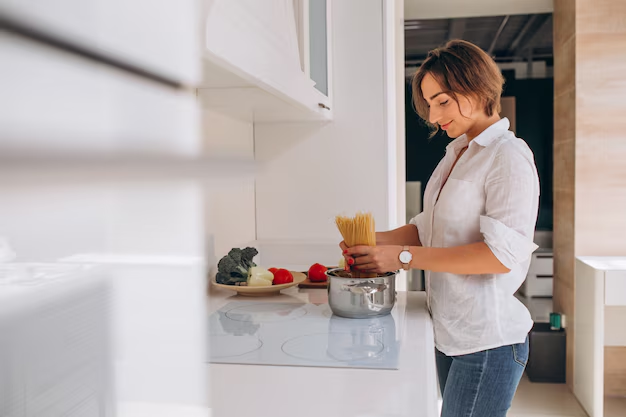Setting the Perfect Temperature on Your GE Refrigerator: A Comprehensive Guide
Is your GE refrigerator not cooling as expected? Or is it chilling your food to the point of iciness? Ensuring your refrigerator is set to the ideal temperature is essential for food safety and energy efficiency. In this guide, we'll walk you through the steps to correctly adjust the temperature settings on your GE refrigerator, explore common issues, and provide valuable tips for maintaining an optimal environment inside your fridge.
📏 Understanding the Ideal Temperatures
Your refrigerator plays a crucial role in preserving the freshness of your food. To achieve this, setting the temperature to the right level is vital.
What is the Ideal Refrigerator Temperature?
For the refrigerator section, the optimal temperature is typically around 37°F (3°C). This setting ensures that your perishables stay fresh without freezing the contents.
For the freezer section, aim for 0°F (-18°C) to keep your frozen foods safe and maintain their quality over time.
Consistently maintaining these temperatures can prevent bacterial growth and ensure food safety.
🔧 How to Set the Temperature on Your GE Refrigerator
Locating the Temperature Controls
Before adjusting the temperature, you need to locate the control panel, which can vary depending on your GE refrigerator model. Here are some common locations:
- Inside the Refrigerator: Look near the upper or middle section.
- On the Door: Some models feature digital displays on the fridge door.
- Top of the Refrigerator Ceiling: Occasionally, controls are located here.
Adjusting the Temperature
For models with a dial or slider:
- Identify the Setting Range: Most dials range from 0 (off) to 9 (coldest).
- Set the Knob: For the refrigerator section, adjust to a setting between 4 and 5. For the freezer, a setting around 5 usually suffices.
- Fine-Tuning: If food isn't as cold as you'd like, gradually adjust the settings colder. Conversely, if items are freezing, adjust them warmer.
For models with a digital display:
- Access the Temperature Controls: Press the designated button or option on the display panel to enter the temperature setting mode.
- Adjust to Optimal Settings: Use the increase/decrease options to set the refrigerator to 37°F (3°C) and the freezer to 0°F (-18°C).
- Save and Monitor: Confirm the new settings and monitor over the next few hours to ensure stability.
🔁 Monitoring and Adjustments
- Patience is Key: After making adjustments, allow at least 24 hours for the temperature to stabilize so the changes can take full effect.
- Use a Thermometer: Place a thermometer inside the fridge and freezer to verify their actual temperatures, ensuring accuracy beyond the display readings.
🛠️ Troubleshooting Common Temperature Issues
Temperature fluctuations and inconsistencies can be frustrating. Here are several common issues and how to resolve them:
Problem 1: Refrigerator Not Cooling Properly
- Check the Door Seals: Ensure they are clean and undamaged to prevent cool air from escaping.
- Avoid Overloading: Too much food can obstruct air circulation, so maintain some space for airflow around items.
- Inspect the Vents: Confirm that internal vents are not blocked by items, which can hinder even cooling.
Problem 2: Foods are Freezing in the Refrigerator
- Adjust Temperature Settings: Consider raising the setting if items regularly freeze.
- Arrange Items with Purpose: Keep liquids and sensitive items away from air vents to prevent accidental freezing.
Problem 3: Consistent Temperature Fluctuations
- Ambient Temperature Effects: If the room is too cold or too warm, it can affect refrigerator performance.
- Regular Maintenance: Clean condenser coils regularly and ensure there's enough ventilation space behind the refrigerator.
🤔 Why Temperature Matters: Health and Efficiency
Setting your refrigerator's temperature correctly isn't just about keeping food tasty—it's critical for your health and wallet.
Food Safety
- Proper temperatures minimize bacterial growth.
- Particular foods, like dairy and meat, require specific storage conditions to stay safe.
Energy Efficiency
- A consistently cold temperature prevents excessive energy use, which in turn lowers your electricity bills.
- Well-maintained refrigerators have longer lifespans, reducing the need for early replacements.
💡 Quick Tips for Optimal Performance
- 🍎 Regular Check-Ups: Inspect seals and look for frost buildup regularly.
- 🔍 Thermometer Use: Periodically use a thermometer to ensure accuracy.
- 😊 Keep it Clean: Ensure vents and coils are dust-free for maximum efficiency.
📋 Visual Summary: Quick Reference Guide
Here's a quick checklist to ensure your GE refrigerator is always at the right temperature:
🔉 Location of Controls: Inside fridge, on door, or refrigerator ceiling.
🌡️ Ideal Temperatures:
- Refrigerator: 37°F (3°C)
- Freezer: 0°F (-18°C)
⚙️ Adjustment Tips:
- Dial: Set between 4-5 for fridge, around 5 for freezer.
- Digital: Adjust to exact degrees using panel.
💡 Key Troubleshooting:
- Check seals and vents.
- Avoid overstuffing to facilitate airflow.
- Monitor ambient room temperature effects.
👍 Regular Maintenance: Keep coils and interior clean.
Consistently maintaining the correct temperature in your GE refrigerator will not only keep your food fresh but also enhance energy efficiency and prolong the life of the appliance. Following the steps outlined above will guide you towards a consistently optimal and worry-free refrigeration experience. Happy chilling!
